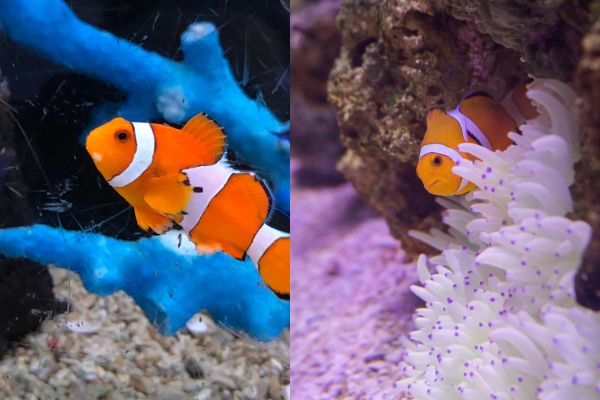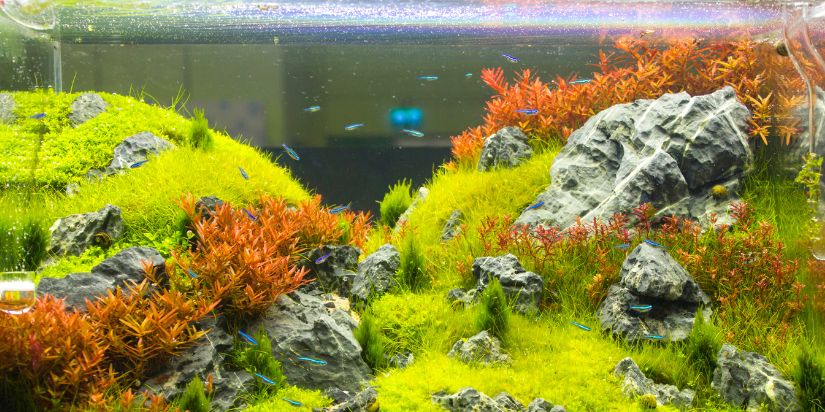Home aquarium maintenance is incredibly involved. You need to clean the tank, change the water, monitor various things and so much more. But all these steps are centered around a single purpose: maintaining optimal health for your aquarium’s ecosystem.
Unfortunately, like every other organism, fish are susceptible to hundreds of potential illnesses. But how do you know when your fish is sick? How can you prevent possible illnesses from spreading through your breathtaking aquarium? The good news is that learning how to clean a home aquarium properly and identify illnesses is an excellent first step.
Below, we discuss these two topics in depth. Before we start, feel free to check out our professional fish aquarium cleaning services (and maintenance services) by clicking the button below.
Fish Disease Types and Symptoms
Inspecting your fish every day for the symptoms of illnesses is crucial. Thankfully, it isn’t that difficult once you know what to look for. Just take a few minutes to look carefully at the fish inside your tank. This is the perfect time to enjoy watching them swim peacefully!
As for what to look out for, that will depend on the illness. Fish diseases can be broken down into a few categories: viral, bacterial, parasitic, fungal and “other.”
If you aren’t sure what type of illness your fish has, try using this diagnostics tool—it allows you to mark all the symptoms you’ve observed. Then, it provides a list of possible causes in order of probability.
Viral Fish Infections
Viruses can be some of the most complex illnesses to diagnose and treat in fish because they aren’t always obvious. Often, they’re caused by bad water conditions and then spread through water or contact.
One of the most common viral infections in freshwater fish is cauliflower disease, also known as lymphocystis. This creates a white cauliflower-like growth on the fish’s body. Any growths, discolorations or general lethargy (like slow swimming) could indicate a viral infection.
Bacterial Fish Infections
Bacterial infections are highly contagious and spread easily from one fish to another within a tank. These should be addressed immediately so they don’t overtake your aquarium’s population.
Symptoms include swelling, scale discoloration, frayed fins and cloudy eyes. These will often be paired with sluggish behavior and a lack of appetite. The best treatment? Quarantines and antibiotics.
Common bacterial infections include:
- Dropsy
- Mouth Fungus
- Fin Rot
- Hole-in-the-Head Disease
Parasitic Fish Infections
Parasitic infections are similarly prone to spreading through your aquarium before you even know they’re there. Symptoms can include growths, redness, discoloration, clamped fins and unusual behaviors. For example, fish may continue rubbing against objects.
Typical treatments for freshwater fish include medications, saltwater baths and temperature increases. Ich, nematodes, anchor worms and gill flukes are common examples of fish parasites.
Fungal Fish Infections
Fungal infections tend to come after some other injury or illness has weakened the fish’s ability to fight off infection. Symptoms include fuzzy-looking growths that are greyish or white. They may appear on the fish’s body, gills, and mouth, eventually killing it.
Common forms include gill rot, body fungus, cotton mouth disease and systemic fungal infections. If discovered, these should be treated with 10mL of 1% phenoxyethanol solution per liter of water in the aquarium.

“Other” Fish Illnesses and Issues
Aside from infectious diseases such as these, there are other miscellaneous ailments. Sometimes, physical injuries happen due to accidents, sharp pieces of décor or bullying from other fish. In these cases, a bit of 2% mercurochrome should help treat the injury. You can also keep the injured fish in very slightly acidic water if they have a good tolerance for it.
Constipation commonly affects fish with compressed bodies like angelfish and can be cleared with dietary changes and food treated with paraffin oil. You may also encounter tumors, which are almost always untreatable and, sadly, require the fish to be put down.
Home Aquarium Maintenance for Disease Prevention
So, what can be done to prevent those illnesses from appearing? Learning how to maintain a fish tank at home is your best option. Below, we share some aquarium maintenance tips to help you get started on the right foot (or fin).
Start Right
The first step in home aquarium maintenance happens before your fish are added to the tank. You’ll need to ensure you’ve allowed your tank to cycle before you start adding fish. You need to give the aquarium time for the nitrogen cycle to build up enough of the good bacteria responsible for converting toxic substances like ammonia into nitrite and then nitrates, an essential part of maintaining the health of your fish.
Adding fish to a tank that hasn’t been properly cycled yet or adding too many fish too fast can lead to many problems. Examples include ammonia poisoning, algae blooms and unnecessary stress that makes them more susceptible to disease.
You should also quarantine your fish for at least two weeks to observe them before introducing them to the aquarium. This way, you can monitor them for any potential infections they may bring into the tank and spread to the other inhabitants. Doing this also allows for a smoother, less stressful transition for them.
Basic Home Aquarium Maintenance Tasks
Once the fish are in the aquarium, proper aquarium care should be practiced to maintain fish health. For example:
- Ensure you feed your fish a nutritious and varied diet
- Keep up with weekly partial water changes
- Closely monitor temperature, pH, ammonia and nitrite levels
However, it is possible to go overboard with aquarium care to a point that harms fish health. Overcare is something many owners are guilty of. Using lots of pH-altering additive products due to an obsession with the “perfect” pH or changing too much water at one time creates an environment of shifting, unstable conditions. This, in turn, puts a lot of constant stress on fish’s bodily systems.
Of course, since hundreds of different diseases can afflict a fish, even the most experienced aquarist can’t prevent them all. Sometimes, you have to be vigilant so you can catch it early if something does occur.
Need Professional Home Aquarium Maintenance?
Keeping up with the many tasks involved in home aquarium maintenance can be tasking and time-consuming. At Living Art Aquatics, we’re ready to give you a professional helping hand! We have the knowledge, tools and expertise to keep your aquarium running smoothly so your fish stay healthy! Give us a call today to learn more about our professional services.
Editor’s Note: This blog was originally published in September of 2016 and updated in February of 2024.





